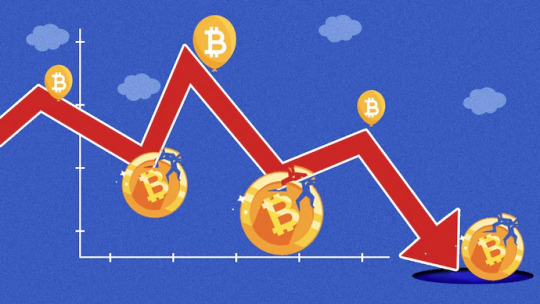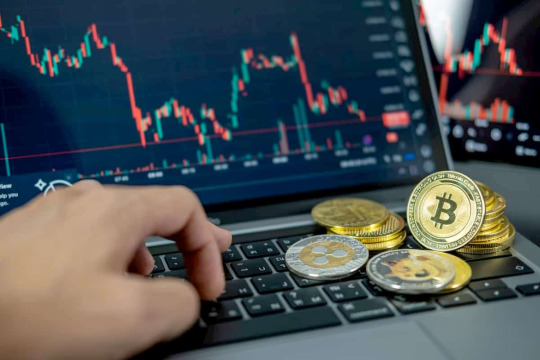Don't wanna be here? Send us removal request.
Text
How to Sell Crypto During a Market Crash

Cryptocurrency markets are known for their extreme volatility, and market crashes can be stressful for even seasoned investors. However, a market downturn doesn’t have to spell disaster. Knowing how to sell crypto strategically during a crash can help minimize losses and position you for future opportunities. Here’s a guide to navigating these challenging times effectively.
Understand Market Conditions
Before deciding to sell, assess the overall market sentiment. A market crash can occur due to regulatory news, macroeconomic trends, or panic selling. Understand the root cause of the crash to determine if it’s a temporary dip or a long-term decline. This insight can help you decide whether to sell or hold for a potential recovery.
Set Realistic Goals
When selling during a crash, having a clear objective is essential. Are you trying to cut your losses, protect profits, or free up capital for other investments? Setting realistic goals ensures you make rational decisions instead of emotional ones. Selling impulsively during a panic can lead to regret later if the market rebounds quickly.
Evaluate Your Portfolio
Not all cryptocurrencies are affected equally during a market crash. Review your portfolio to identify assets that may be more resilient or likely to recover. You could strong-performing assets with solid fundamentals while selling off weaker ones. This selective approach can help preserve value in your portfolio.
Use Limit Orders to Your Advantage
When the market crashes, price swings can be unpredictable. Limit orders allow you to sell crypto at a predetermined price, ensuring you don’t sell too low during a sudden drop. This approach provides greater control and helps avoid losses due to panic selling or emotional reactions.
Avoid Selling All at Once
Selling your entire crypto holdings during a crash may not be the best strategy. Instead, consider selling in increments. This method, known as dollar-cost averaging out, allows you to mitigate losses while retaining some exposure to the market for potential rebounds.
Beware of Fees and Taxes
Selling crypto during a crash can still incur fees and tax obligations, which can add up quickly. Research the tax implications of selling your digital assets and account for transaction fees. This will help you calculate the amount you’ll receive after selling, preventing unwelcome surprises.
Keep Emotions in Check
Market crashes often trigger fear, uncertainty, and doubt. Emotional decision-making can lead to costly mistakes, such as selling at the lowest point of a dip. Stay calm, rely on your research, and stick to your strategy. Avoid making hasty decisions based on fear of further losses.
Look for Future Opportunities
A market crash can also present opportunities. After selling, consider reinvesting when prices stabilize or start recovering. Planning your next move can turn a challenging market into a stepping stone for growth.
Selling crypto during a market crash requires careful planning and a clear strategy. You can confidently navigate the downturn by understanding market conditions, setting realistic goals, and staying rational. Remember, the key is to minimize losses while keeping an eye on long-term opportunities. Crashes are a natural part of the crypto market cycle, and with the right approach, you can come out stronger on the other side.
0 notes
Text
How to Safely Sell Ethereum on Crypto Exchanges

Selling Ethereum (ETH) on crypto exchanges is common for users who want to convert their digital assets into fiat currency or other cryptocurrencies. However, following the right steps to ensure the transaction is safe and profitable is essential with the volatile crypto market. Here's a guide on how to sell Ethereum securely on crypto exchanges.
Choose a Reliable Crypto Exchange
The first step in selling Ethereum is selecting a reputable crypto exchange. Choosing a platform with a solid reputation for security, ease of use, and reliable customer service is important. Look for exchanges registered in your country that comply with local regulations. Reading user reviews and checking for industry certifications can help ensure the platform is trustworthy.
Some popular exchanges offer strong security features, such as two-factor authentication (2FA), cold storage for funds, and insurance in case of breaches. These measures add an extra layer of protection to your assets while you conduct the sale.
Create and Verify Your Account
Once you've chosen your exchange, you must create an account. Typically, you'll provide your email address, create a password, and verify your identity by submitting personal information, such as your government-issued ID and proof of address. These verification steps ensure the platform complies with anti-money laundering (AML) and know-your-customer (KYC) regulations.
This process can take a few hours or days, depending on the exchange. Once you're verified, you'll have access to all of the platform's features, including the ability to sell Ethereum.
Deposit Ethereum into Your Exchange Wallet
After setting up your account, the next step is to deposit the Ethereum you want to sell. Navigate to the "Deposit" section of your exchange account, where you'll find a unique wallet address for Ethereum. Transfer your ETH from your wallet to this address.
Be mindful of the gas and transaction fees associated with moving Ethereum. Gas prices fluctuate based on network congestion, so it’s wise to wait for lower fees if possible. Always double-check the wallet address to avoid sending your funds to the wrong destination.
Place Your Sell Order
You can place a sell order once your Ethereum is in your exchange wallet. There are generally two types of orders you can place:
1. Market Order: This type of order allows you to sell Ethereum immediately at the best available market price. It's fast and ideal for those who want to sell Ethereum quickly.
2. Limit Order: With a limit order, you specify the price you'd like to sell Ethereum. Your order will only execute once the market reaches your desired price. This is ideal for those looking to sell Ethereum at a specific value, but it may take longer to fulfill.
Choose the option that best fits your goals and the market conditions. Market orders are the easiest for those looking for a quick sale, but limit orders can help you get a better price if you're not in a rush.
Confirm the Transaction
Before finalizing the transaction, double-check all the details. Verify the amount of Ethereum you're selling, the price (if using a limit order), and any applicable fees. Crypto exchanges charge a small transaction fee, depending on the platform and the sale size.
Once you’ve confirmed the details, complete the sale. The funds will be credited to your exchange account, typically in your local currency or stablecoin. Some exchanges may require a withdrawal fee to cash out in fiat currency.
Withdraw Your Funds
After selling your Ethereum, you can transfer funds to your bank account or crypto wallet. To do this, navigate to the "Withdraw" section of the exchange, choose your preferred withdrawal method (bank transfer, PayPal, or other options), and input your payment details.
Ensure you know any withdrawal fees, as these can vary. Some exchanges offer free withdrawals for certain amounts or methods, while others charge a flat fee or a percentage of the withdrawal amount.
Monitor Your Transaction
Even after completing the sale, monitoring your transaction is a good idea. Ensure the funds have been successfully transferred to your bank account or wallet. If you encounter any issues, contact customer support immediately.
Selling Ethereum on crypto exchanges can be straightforward if you follow the steps to ensure your funds are safe. Choose a trustworthy platform, secure your account, and verify transaction details before finalizing any sale. These precautions allow you to sell Ethereum and confidently manage your digital assets.
0 notes
Text
Selling Bitcoin: Strategies for Maximizing Profits

As the cryptocurrency market evolves, many investors ask how to sell Bitcoin for the best possible return. With the volatility of Bitcoin prices, employing strategic methods can make a significant difference in the profits you realize from your investment. This article outlines various strategies to help you maximize your profits when you decide to sell Bitcoin.
Understand Market Trends
Before you sell Bitcoin, staying informed about market trends and conditions is crucial. Bitcoin's price fluctuates due to various factors, including market demand, investor sentiment, and macroeconomic events. Regularly monitoring these trends can help you identify the best time to sell. Utilize resources like cryptocurrency news websites and market analysis reports to understand how external events may impact Bitcoin's price.
Set Clear Goals
Establishing clear financial goals is essential when planning to sell Bitcoin. Before entering the market, determine your target profit margin, a specific dollar amount or a percentage increase from your original investment. Clear goals will help you stay disciplined and avoid impulsive decisions based on short-term market movements.
Use Dollar-Cost Averaging
Dollar-cost averaging is an investment strategy in which you sell Bitcoin in smaller amounts over a set period rather than all at once. This approach helps mitigate the risks associated with market volatility. Use price fluctuations by spreading your sales, potentially achieving a better average selling price. This strategy is particularly useful if you anticipate that Bitcoin's price may rise or fall soon.
Consider Tax Implications
Selling Bitcoin can have tax consequences, as cryptocurrencies are often treated as property in many jurisdictions. Before you sell Bitcoin, research the tax implications of your transactions. Depending on your country’s regulations, you may need to pay capital gains tax on your profits. Understanding these implications will allow you to calculate your net profit accurately and avoid any unexpected tax liabilities.
Set Stop-Loss Orders
A stop-loss order is an effective tool for protecting your investment from significant losses. By setting a stop-loss order, you can specify a price at which your Bitcoin will automatically be sold if the market price drops below that level. This strategy can help you minimize losses in a declining market and ensure that you lock in profits when prices are high.
Monitor Exchange Fees
When you decide to sell Bitcoin, be aware of the fees associated with different exchanges. Transaction fees can vary significantly from one platform to another, impacting your overall profit. Research various platforms and choose one that offers competitive fees. Additionally, keep an eye on withdrawal fees if you transfer your funds to your bank account.
Stay Emotionally Detached
Selling Bitcoin can evoke strong emotions, especially during market volatility. Fear and greed can lead to impulsive decisions that may not align with your investment strategy. To maximize profits, you must remain emotionally detached from your investments. Stick to your predetermined selling strategy and avoid making decisions based on panic or excitement.
Diversify Your Portfolio
While Bitcoin can be lucrative, diversifying your portfolio can help mitigate risks and increase your overall returns. Consider selling some of your Bitcoin holdings and reallocating those funds into other cryptocurrencies or investment vehicles. This strategy can help you capitalize on different market opportunities and reduce your exposure to Bitcoin's volatility.
Selling Bitcoin can be a rewarding venture if approached strategically. You can maximize your profits by understanding market trends, setting clear goals, and employing effective selling strategies. Remember to consider tax implications, use stop-loss orders, and monitor fees associated with exchanges. By staying disciplined and emotionally detached, you can navigate the complexities of the cryptocurrency market and make informed decisions that enhance your financial success.
1 note
·
View note
Text
Exploring Ethereum: Where to Buy and Invest

Ethereum has emerged as a leading cryptocurrency, captivating the attention of investors and enthusiasts alike. As the second-largest digital asset by market capitalization, Ethereum's unique features and growth potential make it an attractive option for diversifying their investment portfolios. If you're interested in buying Ethereum, understanding where and how to purchase this digital currency is crucial. This article explores various avenues for acquiring Ethereum and offers insights into making informed investment decisions.
Understanding Ethereum
Before delving into the purchasing options, it’s essential to understand Ethereum. Launched in 2015 by Vitalik Buterin and a group of developers, Ethereum is a decentralized platform that enables developers to build and deploy smart contracts and decentralized applications (dApps). Unlike Bitcoin, which primarily serves as a digital currency, Ethereum’s versatility allows it to support many applications beyond simple transactions, including decentralized finance (DeFi), non-fungible tokens (NFTs), and more.
Cryptocurrency Exchanges
One of the most common ways to buy Ethereum is through cryptocurrency exchanges. These platforms allow users to trade various cryptocurrencies, including Ethereum, for fiat currency (like USD) or other digital assets. When selecting an exchange, consider security, fees, user experience, and available payment methods. Most exchanges offer an easy signup process, allowing you to create an account, verify your identity, and link a payment method. Once your account is set up, you can buy Ethereum using bank transfers, credit cards, or other cryptocurrencies.
Peer-to-Peer (P2P) Platforms
Peer-to-peer platforms provide another avenue for buying Ethereum. These platforms connect buyers and sellers directly, enabling individuals to negotiate prices and payment methods. P2P platforms often have built-in escrow services, which add a layer of security to transactions. When using a P2P platform, checking the seller's reputation and transaction history is essential to ensure a safe purchase. This method can be particularly beneficial if you seek localized transactions or alternative payment options.
Crypto ATMs
Cryptocurrency ATMs are physical machines that allow users to buy Ethereum using cash or credit cards. These ATMs provide a convenient and straightforward method for purchasing digital currencies, especially for those who prefer to use something other than online exchanges. However, it’s essential to note that fees at crypto ATMs can be higher than those on exchanges, so it's wise to check the rates before proceeding.
Investment Platforms
For those who prefer a more hands-off approach to investing, certain investment platforms allow users to buy Ethereum without needing to manage the assets directly. These platforms enable you to invest in Ethereum through a managed fund, offering diversification and professional management. While this option may come with higher fees, it can be an excellent choice for those new to cryptocurrency or those who want to minimize their involvement in the day-to-day management of their investments.
Making Informed Investment Decisions
Thorough research is essential when considering where to buy Ethereum. Look into the exchange or platform’s security measures, user reviews, and the fees associated with buying Ethereum. Additionally, stay informed about market trends and developments within the Ethereum ecosystem. As with any investment, investing only what you can afford to lose and diversifying your portfolio to mitigate risks is crucial.
Buying Ethereum offers a unique opportunity to participate in the evolving world of digital currencies. Whether you choose a cryptocurrency exchange, a peer-to-peer platform, a crypto ATM, or an investment platform, understanding your options and conducting thorough research will help you make informed decisions. As you embark on your journey to buy Ethereum, stay vigilant and continuously educate yourself about this dynamic market to maximize your investment potential.
0 notes
Text
A Simple Guide on How to Sell Bitcoin

Selling Bitcoin can be an essential decision for anyone involved in cryptocurrency trading. Understanding the selling process is crucial if you’re looking to cash out, reinvest, or diversify your portfolio. Here’s a comprehensive guide to help you navigate the steps of selling Bitcoin effectively.
Understanding Bitcoin
Bitcoin is the first and most widely recognized cryptocurrency. It operates on a decentralized network, allowing users to transfer value without intermediaries. Its value can fluctuate significantly, influenced by market demand, technological developments, and regulatory news. Before you sell Bitcoin, it’s essential to grasp its current market conditions to maximize your returns.
Choosing the Right Time to Sell
Timing your sales can significantly impact your profits. Monitor market trends, news, and price movements to identify the right moment to sell. Many investors use technical analysis tools to predict price movements and assess market sentiment. Additionally, monitoring economic indicators can help you make informed decisions.
Selecting a Selling Method
There are several ways to sell Bitcoin, each with pros and cons. Here are a few popular methods:
1. Cryptocurrency Exchanges. Exchanges are platforms that allow users to buy and sell Bitcoin. They offer a user-friendly interface and provide various trading pairs. You can set your selling price when using an exchange, and the platform will match you with a buyer. However, be aware of transaction fees, which vary significantly between platforms.
2. Peer-to-Peer (P2P) Trading. P2P trading platforms connect buyers and sellers directly. This method allows for more flexibility in terms of payment options and pricing. You can negotiate terms directly with the buyer, leading to better deals. However, using reputable platforms and taking precautions is crucial to avoid scams.
3. Bitcoin ATMs. Bitcoin ATMs allow you to sell Bitcoin for cash instantly. They offer convenience and anonymity, making them a popular choice for those looking to liquidate their holdings quickly. However, transaction fees at ATMs can be higher than other methods, so check the fee structure before proceeding.
4. Over-the-counter (OTC) Trading. OTC trading is suitable for large-volume transactions. It involves direct negotiation between the buyer and seller, typically facilitated by a broker. This method can help you avoid slippage and unfavourable market prices but may require a more significant amount of Bitcoin to make it worthwhile.
Preparing to Sell
Before selling Bitcoin, ensure you have your wallet ready. Transfer your Bitcoin to the exchange wallet if you're using an exchange. If selling P2P or at an ATM, ensure you can access your wallet securely.
Also, consider any legal and tax implications of selling Bitcoin in your jurisdiction. Keep records of your transactions, as you may need them for tax reporting.
Executing the Sale
Once you’ve decided on the method and timing, execute the sale. Follow the platform's instructions carefully, confirming the sale amount and desired price. If selling P2P, communicate clearly with the buyer to finalize the transaction smoothly.
Selling Bitcoin can be straightforward if you understand the options and prepare adequately. You can successfully navigate the process and make the most of your investment by choosing the right method, timing your sale appropriately, and staying informed about market conditions. Being informed is key to successful cryptocurrency trading, whether you are selling for cash, reinvesting, or diversifying your portfolio.
0 notes
Text
Exchange Crypto: How to Maximize Profits Safely

Cryptocurrency trading is rapidly becoming a popular way to generate profits. However, the volatile nature of digital assets means traders must take precautions to ensure safety while maximizing their returns. Understanding the right strategies is essential to exchange crypto effectively and secure profits. This article will provide key tips to help you confidently exchange crypto while keeping your profits intact.
Choose the Right Exchange Platform
The first step in safely exchanging crypto is selecting the right platform. Not all platforms are created equal, so evaluating your options is important based on their security features, ease of use, and transaction fees. A platform with robust security measures such as two-factor authentication and encryption can significantly reduce the risk of fraud or hacking. While convenience and low fees are tempting, security should always come first when you exchange crypto.
Understand Market Conditions
Before you exchange crypto, it’s crucial to understand the current market conditions clearly. Cryptocurrencies are highly volatile, meaning their prices can fluctuate dramatically in short periods. To maximize profits, you must stay informed about market trends, news, and events that can influence crypto prices. Use charts, analytics, and news feeds to keep track of changes in the market, and consider setting alerts for when prices hit certain thresholds. Timing is everything in crypto trading, so having the right information at your fingertips will allow you to make informed decisions.
Diversify Your Portfolio
When looking to maximize profits safely, diversification is key. Instead of putting all your money into one cryptocurrency, spread your investments across several coins. This reduces the risk of losing your entire investment if one coin’s value suddenly drops. Diversification benefits you from different market conditions, as not all cryptocurrencies move in the same direction. A balanced portfolio increases the chances of gaining from different crypto markets over time, thus enhancing your overall profits.
Set Clear Profit and Loss Limits
Establishing clear profit and loss limits is one of the most effective strategies to safeguard your profits while trading crypto. Setting stop-loss orders can help prevent significant losses by automatically selling your assets if their price drops below a certain level. Similarly, take-profit orders ensure you capture gains when the price reaches your desired target. These automated mechanisms are essential for minimizing risks in a volatile market, allowing you to lock in profits and reduce potential losses without constantly monitoring the market.
Manage Your Emotions
The crypto market can be emotionally charged, especially when prices experience sharp rises or falls. Emotional trading often leads to poor decisions, such as buying during a price surge or panic-selling during a market dip. Managing emotions and sticking to your strategy is crucial to exchange crypto safely. Avoid reacting to short-term market movements, and always keep your long-term goals in mind. A clear plan can help you maintain discipline and avoid impulsive decisions that could harm your profits.
Secure Your Digital Assets
Once you have successfully exchanged crypto, storing your digital assets securely is vital. Consider using cold wallets (offline wallets) for long-term storage, as they are less vulnerable to hacking than online wallets. Regularly update your passwords and enable multi-factor authentication on your accounts. Additionally, be mindful of phishing scams and other fraudulent activities that target crypto traders. Protecting your assets after you exchange crypto is just as important as the exchange process itself.
Adopting a strategic and disciplined approach to maximize your profits safely when you exchange crypto is essential. Start by choosing a secure platform, diversifying your portfolio, and staying informed about market trends. Setting clear limits, managing your emotions, and protecting your digital assets are key to successfully trading. By following these best practices, you can minimize risks and enhance your potential for profitable crypto trading.
1 note
·
View note